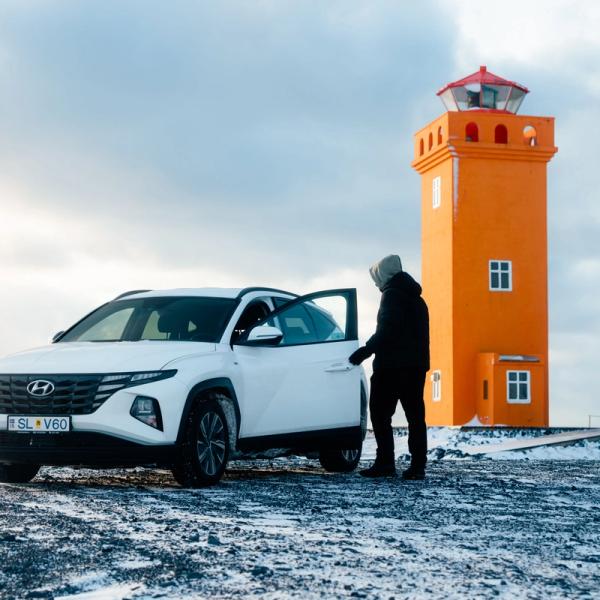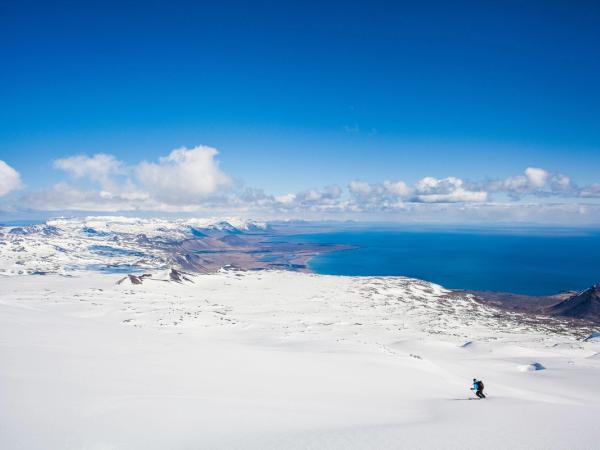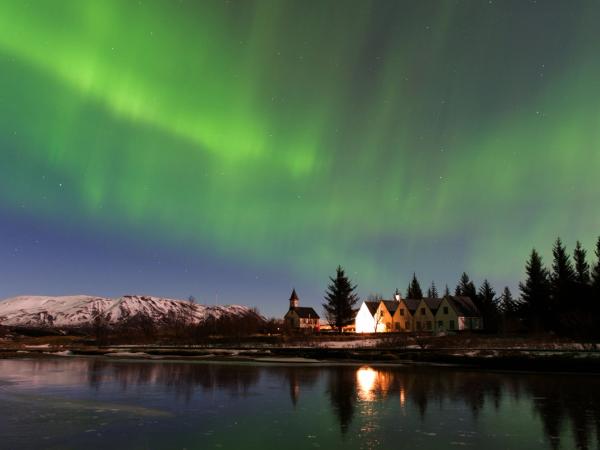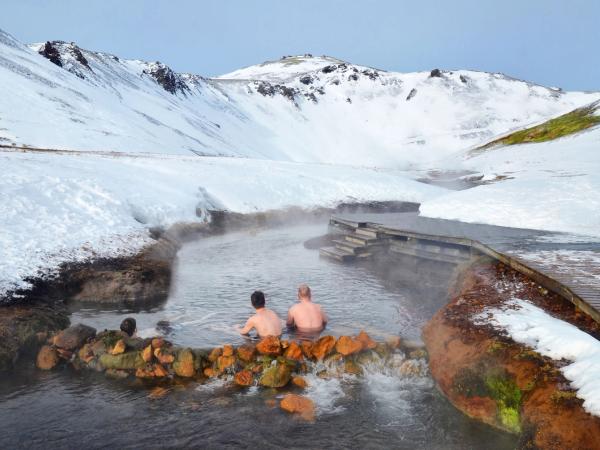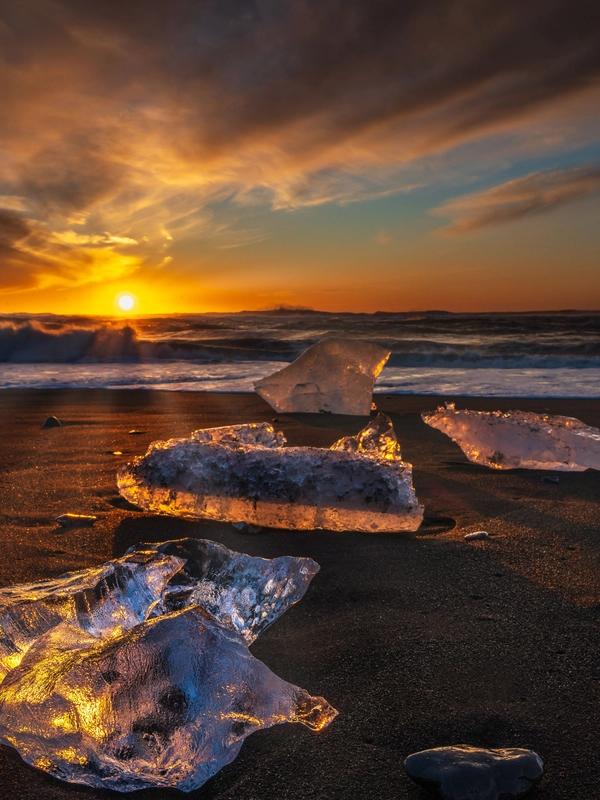
What to expect: Weather in Iceland in February
The idea of traveling to Iceland in February might sound a bit tricky at first. Many people believe that coming to the country in winter can be challenging, and it's true, but it also has its upsides.
Despite the cold and short days, February has its own unique charm, offering opportunities for winter activities. For example, it’s a great time to see the Northern Lights. In this guide, we’ll cover everything you need to know about the weather in Iceland in February, so you can be prepared for what you will encounter.
Key Takeaways
- The country's average temperature is 0°C (32°F). In Reykjavik, it oscillates between -2°C (28.4°F) and 3°C (37°F).
- There are 7 hours of daylight at the beginning of February, and they increase to 10 by the end of the month.
- The number of days of rain or snow is around 15.
- Driving can be challenging, but it can be done with careful preparation.
What is the Average Temperature in February in Iceland?
February in Iceland remains deep in the winter season, and while the country’s subarctic climate means cold temperatures are expected, it’s not as extreme as you might think. Thanks to the influence of the ocean, Iceland's temperatures are more moderate compared to other places at similar latitudes.
Winters are long in Iceland, roughly from November to March. So February is still deep winter here. The average temperature in the country goes between -3°C (26.6 °F) and 3°C (37°F). While this may sound cold, it’s manageable, especially if you’re dressed appropriately. However, it’s important to note that these are just averages. Depending on where you are in Iceland, temperatures can fluctuate
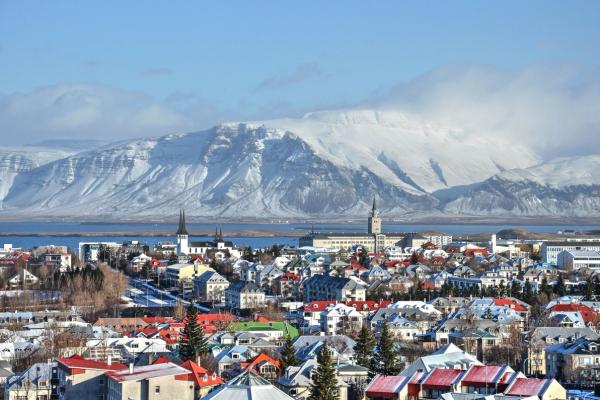
Regional Temperature Variations
Despite being a relatively small country, the temperature in Iceland varies a lot from region to region.
Reykjavik and Southern Iceland
The southwest of the country has a milder climate than the rest of the island. On the other hand, this area is wet and windy, so the temperature might feel colder than it actually is, and it can rain more than it snows. Here, temperatures tend to stay closer to the freezing point, ranging between 0°C (32°F) and 4°C (39°F).
Northern Iceland
The north is one of the coldest regions in the country, apart from the central Highlands. The average temperature in northern Iceland can range between -3°C (27°F) and -8°C (17°F), with the temperatures frequently dropping below -10°C (14°F) at night. This region is also more likely to experience heavy snowfall throughout February.
East Iceland
The eastern part of the country, particularly in the remote East Fjords, has very similar weather to the north. Temperatures here can also dip below freezing, especially in the mountainous areas. On the coast, the weather is closer to the conditions in southern Iceland.
Westfjords
The Westfjords, one of the most remote regions of Iceland, can be incredibly cold and challenging to visit during February. Snowfall is heavy, and temperatures can drop below freezing for much of the month. Many roads in the region are closed in winter due to the adverse weather.
The Highlands
The Central Highlands are normally closed and inaccessible during February due to extreme cold, deep snow, and dangerous driving conditions. In this region, temperatures can drop to -15°C (5°F) or even lower, making it one of the coldest parts of Iceland.
| Region | Average temperature in ºF | Average temperature in ºC |
| Reykavik and Southern Iceland | Between 32°F and 39°F | Between 0°C and 4°C |
| North Iceland | Between 27°F and 17°F | Between -3°C and -8°C |
| East Iceland | Between 27°F and 17°F | Between -3°C and -8°C |
| Westfjords | Between 28 °F and 19°F | Between -2° and -7° |
| The Highlands | Up to 5ºF | Up to -15ºC |
Wind Chill and Sudden Temperature Changes
Regardless of where you are in Iceland, wind plays a significant role in how cold it feels. The wind chill can make a relatively cold day feel much colder, especially along the coast, where winds are strongest.
In addition, Iceland's weather is known for being unpredictable. Temperatures can change quickly throughout the day, sometimes rising above freezing only to drop again a few hours later. This variability means that you have to be prepared for changing conditions.
How Much Does It Rain in February in Iceland?
Precipitation is frequent in February, and you can expect a mix of rain, snow, and sleet. Or even the three of them combined. Rain is more common in the southern coastal regions due to slightly warmer temperatures, while snowfall is more likely in the north and in higher elevations. In Reykjavik, the average number of days of precipitation during the month is 15.
Iceland’s weather can change rapidly. One minute you may experience clear skies, and the next, you could find yourself in the middle of a storm. While it might not rain or snow continuously, the weather can shift quickly, so it’s essential to be prepared and dress accordingly.
Snow and Winter Conditions
Snow is very common in February in Iceland, particularly in the northern and eastern parts of the country. In these regions, snow can cover the ground for weeks. Reykjavik and the south tend to see less snow accumulation, but snowstorms can still hit at any time.
Daylight Hours in February
Winters in Iceland, as well as in other countries far up north, have short daylight hours. However, in February, there’s a noticeable increase in daylight compared to December and January.
At the start of the month, you can expect about 7 hours of daylight, with the sun rising around 10:00 AM and setting at 5:00 PM in Reykjavik. By the end of the month, the daylight hours extend up to 10 hours.
This increase in daylight gives you more time to explore Iceland’s stunning landscapes and enjoy outdoor activities. At the same time, the night is still long enough, which can be very good if you want to see the Northen Lights.

The Weather in Different Regions of Iceland in February
Although Iceland is not a huge country, the weather conditions can vary significantly depending on the region you’re visiting. The latitude, proximity to the sea, and altitude can have a huge effect on the weather.
Reykjavik and the Southwest
In Reykjavik and the surrounding areas, temperatures are relatively mild, usually a couple of degrees above or below freezing. Snow and rain are both common, but they tend to alternate rather than accumulate heavily. Wind is frequent, which can create the feeling that it’s colder than it actually is.
The South Coast
This region is often slightly warmer than the north. However, it also tends to be wetter, with more rain than snow, though snow can still occur. Wind is fairly common, with strong gusts sometimes, especially along the coast.
The North
The northern regions of Iceland experience colder temperatures, and snow is much more frequent. Akureyri, Iceland’s second-largest city, often has snow-covered streets throughout February.
The East Fjords
Similar to the north, the East Fjords tend to be colder and see more snow. The fjords are often beautifully blanketed in snow during February, offering stunning views. It can be difficult to navigate the region if the weather is adverse.
The Highlands
The Highlands are generally inaccessible in February due to deep snow and harsh winter conditions. Most F-roads (mountain roads) are closed until late spring or summer, so it’s best to avoid planning any highland adventures in the winter months.
February 2025 Weather Report
Let’s review the weather in Iceland for February 2025—temperature, rain, snow, and sunshine—to see how it turned out.
February 2025 was warm and wet, with hardly any snow. Winds mostly came from the south, with some bad storms, especially early on. The roughest days were February 5 and 6, when a strong southerly wind hit the whole country. It was one of the worst storms in a while—travel stopped, and there was damage in a lot of places. Here’s what the details tell us:
(Most of this comes from Vedur.is)
Temperatures
February was warmer than usual pretty much everywhere.
- Reykjavík: The average temperature was 3.1°C (37.58°F), 2.6°C above the 1991–2020 average and 2.4°C above the last ten years.
- Akureyri: The average was 1.9°C (35.42°F), 2.7°C above the 1991–2020 average and 2.6°C above the past decade.
- Stykkishólmur (west Iceland): The average was 1.7°C (35.06°F).
- Höfn in Hornafjörður: The average was 3.5°C (38.3°F).
Highest & Lowest Averages Nationwide
- The warmest average was 5.2°C (41.36°F) in Surtsey.
- The coldest average was -3.8°C (25.16°F) at Þverfjall. In places where people live, it was -1.0°C (30.2°F) at Möðrudalur.
- The hottest day was 17.6°C (63.68°F) at Sauðanesviti on the 1st—the highest February temperature there since they started tracking in 1990. Stykkishólmur hit 11.7°C (53.06°F) that day too, a new February record since 1845.
- The coldest day was -14.1°C (6.62°F) at Möðrudalur—pretty mild for a February low in Iceland.
Precipitation
February was rainy, especially in the south and west.
- Reykjavík: Got 141.7 mm of rain, about 55% more than the 1991–2020 average.
- Akureyri: Had 61.5 mm, around 20% above the 1991–2020 average.
- Stykkishólmur: Saw 181.2 mm, more than double the usual amount—one of the wettest Februarys there since 1856.
- Dalatangi: Had 148.0 mm, about 30% above average.
Days with 1.0 mm or More of Rain
- Reykjavík: 19 days, 5 more than usual.
- Akureyri: 9 days, 1 less than average.
Snow
There wasn’t much snow this month.
- Reykjavík: Had just 3 days fully covered in snow, 9 less than the 1991–2020 average.
- Akureyri: Had 4 snowy days, 12 less than usual—the fewest fully snowy February days there since 2006.

Sunshine
- Reykjavík: Got 44.4 hours of sunshine, 17.2 hours below the 1991–2020 average.
- Akureyri: Had 48.1 hours, 14.2 hours above the usual amount.
Driving in Iceland in February
The best way to move around Iceland is by car. This way, you can explore the country at your own pace and reach every part that you’re planning to visit. However, driving in Iceland during February can be a challenge, especially if you’re not used to winter driving conditions in the country.
Snow and ice are common on the roads, and strong winds can create additional hazards. That said, with the right preparation and caution, it’s possible to explore Iceland by car in February.
Here are some tips for driving in February:
- Rent a 4x4 vehicle: A four-wheel-drive vehicle is essential for navigating snowy and icy roads. Make sure that the vehicle is equipped with snow tires for better traction.
- Check road conditions: The Icelandic Road and Coastal Administration’s website offers real-time updates on road conditions and closures. It’s crucial to check this information regularly, especially before setting out.
- Be prepared for ice: Black ice is a frequent hazard on Icelandic roads, particularly in the early morning and late evening. Drive slowly and cautiously.
- Be flexible: As we were saying, some roads may be closed due to the weather. Have a backup plan and adapt if there are delays.
What to Pack for the Weather in February
Packing for Iceland in February requires a bit of planning, as you’ll need to be prepared for cold temperatures, wind, and wet conditions. Here’s a list of essential items to bring:
- Layered clothing: Start with thermal base layers, followed by insulating layers such as fleece or wool, and finish with a waterproof and windproof outer layer. This system will keep you warm while allowing you to adjust to changing temperatures.
- Waterproof gear: A waterproof jacket and pants are a must, especially when exploring nature.
- Hat, gloves, and scarf: Don’t forget to pack accessories to protect yourself against the wind and cold.
- Sturdy, waterproof boots: Walking on icy or snowy surfaces is much easier with proper shoes, so bring warm, waterproof boots with good grip.
- Swimsuit: This might seem strange, but Iceland is famous for its geothermal pools and hot springs. Taking a hot natural bath while the temperature outside is low is just fantastic.
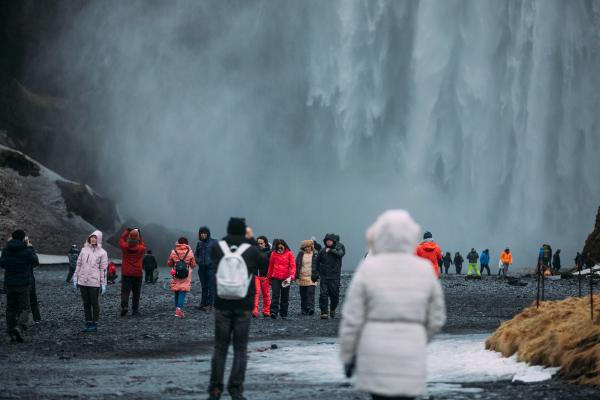
What to Do in Iceland in February
Despite the cold, February is a great time to experience some of Iceland’s unique activities. As the daylight hours are not long, plan outdoor activities for those moments and leave things that can be done inside for the evenings.
- Chase the Northern Lights tours: February offers good opportunities to see the Northern Lights, thanks to the long nights.
- Visit the ice caves and glaciers: One of the perks of coming to Iceland in February is that the glaciers and ice caves are at their best moment. The cold makes it safer to walk on the ice. The best area for this is within Vatnajökull National Park.
- Hot springs and geothermal pools: The perfect way to end your day of exploring is by taking a relaxing hot bath in one of the many natural hot springs or geothermal pools there are in the country.
- Skiing and snowboarding: The ski resorts in Iceland are in full swing during February.
Cultural Events and Festivals in February
- Winter Lights Festival: Held in Reykjavik at the beginning of February, this festival celebrates the return of daylight with art installations, light shows, and cultural events.
- Þorrablót: A traditional winter feast, Þorrablót is celebrated with traditional Icelandic food, including fermented shark, cured meats, and rye bread.
Travel Tips
- Plan for the weather: Always check the weather forecast and road conditions before setting out, as conditions can change rapidly.
- Book activities in advance: Winter activities can fill up quickly, so it’s best to book ahead of time.
- Be flexible: Iceland’s weather is famously unpredictable, so it’s important to be flexible with your plans. Always have a backup activity in mind, just in case.
- Respect nature: Iceland’s natural environment is fragile, and it’s everyone’s duty to help preserve it. Stick to marked paths, follow local guidelines, and be mindful of the impact of your visit on the landscape.
Conclusion
Iceland in February may be cold and unpredictable, but it’s also a magical time to visit. The landscapes look fantastic at this time of the year, with chances to practice winter sports, and it’s a great time to see the Northern Lights.
With a little bit of preparation, your time in Iceland during this month can be a great adventure.

